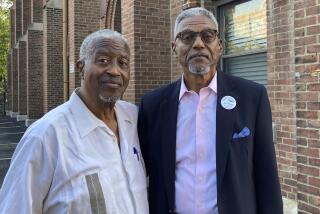Ernest Hendon, 96; Tuskegee Syphilis Study’s Last Survivor
- Share via
Ernest Hendon, the last surviving participant in the infamous Tuskegee Syphilis Study, the U.S. government’s 40-year study of the effects of untreated syphilis on a group of black men in rural Macon County, Ala., has died. He was 96.
Hendon, who was in the control group that did not have syphilis, died Jan. 16 of natural causes associated with aging in a hospital in Opelika, Ala., according to his niece, Dorothy Thomas.
Hendon was one of 623 black men who unwittingly participated in the U.S. Public Health Service study of “the effects of untreated syphilis in the Negro male.”
The study began in 1932 and ended in 1972 after former Public Health Service investigator Peter Buxton exposed the study’s unethical procedures to an Associated Press reporter.
Living in a rural area where doctor visits were a rarity, the men in the study were induced to participate by the promise of free health care, free transportation to and from hospitals and free hot lunches when they got there.
Hendon, who grew up on the family farm with nine siblings, told AP in 2001 that he had no idea what he was getting into. “They said it was a study that would do you good,” he said.
Hendon and his late brother, Louie, were among a control group of about 200 men who did not have syphilis. About 400 other participants had been picked for the study because they already had the disease. At the time, the Tuskegee area reportedly had the highest syphilis rate in the nation.
The men, however, were not told they had the highly contagious, sexually transmitted disease. If left untreated, syphilis can cause blindness, deafness, mental illness, heart failure, paralysis and bone deformities.
Those in the study who had syphilis were told only that they had “bad blood.”
Treatment for the disease was withheld -- even after penicillin therapy became widely available in the 1940s and despite an Alabama law requiring treatment of syphilis sufferers.
The study was conducted to determine from autopsies what the disease does to the human body. And to help ensure that their families would agree to autopsies when participants died, the government offered the men burial insurance to cover the cost of their caskets and graves.
By the time the study was exposed in 1972, 28 participants reportedly had died of syphilis, 100 were dead of related complications, at least 40 wives had been infected and 19 children had contracted the disease at birth.
News of the study -- headlines ranged from “Nightmare Experiment” to “Official Inhumanity” -- prompted a landmark debate among doctors, scientists and public officials over the ethics of using human beings in clinical experiments.
And, public health experts say, awareness of the notorious study has contributed to distrust of official medical studies among many minorities.
In 1973, Tuskegee civil rights lawyer Fred Gray, who had attained national prominence by defending Rosa Parks and the Rev. Martin Luther King Jr. in the 1950s, filed a $1.8-billion class-action suit on behalf of the study participants, their families and heirs.
The suit resulted in an out-of-court settlement of more than $10 million in 1975. Legislation was passed to ensure that human subjects of scientific experiments provide informed consent.
The federal government, however, stopped short of admitting wrongdoing.
It was not until 1997 that President Clinton offered an official apology for the study, which he called “shameful” and “clearly racist.”
“They were betrayed,” Clinton said of the participants during an emotional White House ceremony attended by five of the study’s eight survivors. “Their rights were trampled upon.”
At the ceremony, Clinton announced that a $200,000 government grant would help establish a center for bioethics in research and health care at Tuskegee University as part of a memorial to the victims.
Of her uncle’s reaction to Clinton’s apology, Thomas told The Times this week, “The only thing I’ve heard him say is he felt it should have been done a long time ago.”
Hendon was born in Roba, about 12 miles from Tuskegee, in 1907. After his father died in 1933, his niece said, Hendon continued working on the family farm. He and his older brother, Louie, helped their mother raise their eight siblings.
In 1941, the family relocated to Cleveland, and Hendon went to work as a laborer for General Chemical. He was drafted into the Army three months later. After serving in Europe during World War II, he returned to General Chemical, where he worked until retiring in 1969. He later moved back to Roba.
In 2001, the 94-year-old Hendon, hard of hearing and relying on a cane, sat in a front-row seat of the Alabama House of Representatives in Montgomery. There, a resolution expressing “regret for the role of the State of Alabama in the Tuskegee Syphilis Study” was read and presented to him.
“Everybody knows now that we were mistreated,” Hendon said after the brief ceremony. “I’m glad they’re seeing now that it will never happen again.”
By then, Hendon was one of three surviving study participants and the only one who attended the ceremony.
Gray, who accompanied Hendon to the ceremony in Montgomery, told The Times that his death “brings to an end an era of relationships” that the 623 African American men who participated in the Tuskegee Syphilis Study “had with their government.”
“In his case, it was over a 72-year period of time that he made contributions to his government -- 40 of those he did it unwittingly, and the other 32 years was used in trying to bring closure.”
But through a permanent memorial and exhibit at the Tuskegee Human and Civil Rights Multicultural Center, Gray said, “we intend to keep what these men did alive.”
Hendon, who never married, is survived by a sister, Willion Chambliss, of Tuskegee; and two brothers, North Hendon and Willard Moore, both of Cleveland.






